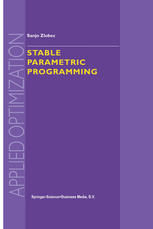

Most ebook files are in PDF format, so you can easily read them using various software such as Foxit Reader or directly on the Google Chrome browser.
Some ebook files are released by publishers in other formats such as .awz, .mobi, .epub, .fb2, etc. You may need to install specific software to read these formats on mobile/PC, such as Calibre.
Please read the tutorial at this link: https://ebookbell.com/faq
We offer FREE conversion to the popular formats you request; however, this may take some time. Therefore, right after payment, please email us, and we will try to provide the service as quickly as possible.
For some exceptional file formats or broken links (if any), please refrain from opening any disputes. Instead, email us first, and we will try to assist within a maximum of 6 hours.
EbookBell Team

4.3
38 reviewsOptimality and stability are two important notions in applied mathematics. This book is a study of these notions and their relationship in linear and convex parametric programming models. It begins with a survey of basic optimality conditions in nonlinear programming. Then new results in convex programming, using LFS functions, for single-objective, multi-objective, differentiable and non-smooth programs are introduced. Parametric programming models are studied using basic tools of point-to-set topology. Stability of the models is introduced, essentially, as continuity of the feasible set of decision variables under continuous perturbations of the parameters. Perturbations that preserve this continuity are regions of stability. It is shown how these regions can be identified. The main results on stability are characterizations of locally and globally optimal parameters for stable and also for unstable perturbations. The results are straightened for linear models and bi-level programs. Some of the results are extended to abstract spaces after considering parameters as `controls'. Illustrations from diverse fields, such as data envelopment analysis, management, von Stackelberg games of market economy, and navigation problems are given and several case studies are solved by finding optimal parameters. The book has been written in an analytic spirit. Many results appear here for the first time in book form.
Audience: The book is written at the level of a first-year graduate course in optimization for students with varied backgrounds interested in modeling of real-life problems. It is expected that the reader has been exposed to a prior elementary course in optimization, such as linear or non-linear programming. The last section of the book requires some knowledge of functional analysis.